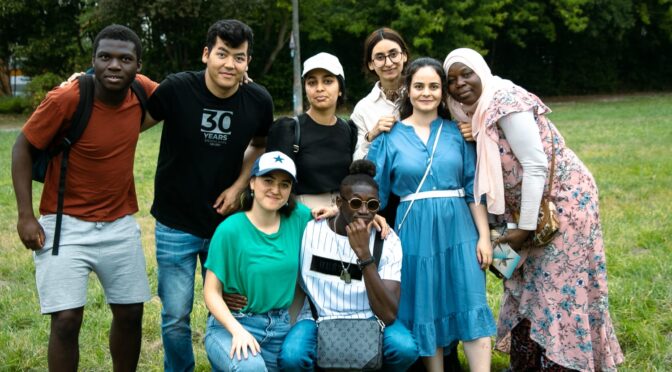JoG-Mitglieder haben einen Artikel verfasst, indem analysiert wird, warum es so wichtig ist, die Fähigkeiten und Erfahrungen von geflüchteten Menschen sowohl im Aktivismus als auch im gesamtgesellschaftlichen Umgang mit Zuwanderung zu nutzen, zu stärken und zu integrieren.
A featherless bird to fly in horizons!
by Shiwa Askandari & Ahmad Hamid Wahidy
In a globalization era one cannot ignore the fact of migration, and with migration we form our human life. Both the migration practices and theories have provided us with the notion that migration has been a continuous social phenomenon throughout human history. Such a phenomenon is not solely related to the social structures but inclusively with political structure, economic trends, geographical changes and demographical exchanges. The government and non-government institutions have recognized this vital process to be formed within policies, structures, international and national budgets. The immigration and asylum process require agreements at macro level, policies at mezzo level and holistic action at micro level.
Migration is an interdisciplinary subject matter. Geographers, economists, sociologists, social psychologists and anthropologists have focused on various theories to explain the typology, reasons and results of migration. Additionally, other disciplines including history, political science, anthropology, demography, cultural studies and law have developed assumptions, theories and research studies. Push and pull models and ‘rational actors’ as the individual decisions form migration. Furthermore, determinism, functionalism and historicism act as internal logic and elegant simplicity which recognizes theoretical stance of migration (King , 2012). Throughout the human history, migration has been recorded within the cultural evidences and human relations. The theoretical foundation of international immigration, for instance, discusses the labor market and wages, movements and decisions (Massy, Arango, & Hugo, 1993). Statistics also report the fact of migration as a phenomenon. Only in Europe and Northern America in the year 2020 total 145,414,863 number of migrants are recorded (Batalova, 2022). The literature, science, cultural evidences and reports have so far proven the phenomenon aspect of migration not as a social problem to be eliminated rather as a phenomenon to be organized, managed and controlled.
Migration at the macro and mezzo levels have been highlighted. The deep dark part of migration remains within the person itself. On one hand, the migration as a broader picture discussed above derives basically on an individual based decision either individual person or as a family and on the other hand it consequently results in individual setting. Likewise, the migrant does not only spend on the migration as a person migrating rather man migrating with culture, norms, values, history and personality. Vitally, immigrants with generational and world class differentiations encounter cultural clashes and value conflicts. In addition, addressing the needs of immigrants with different backgrounds and experiences remains a difficulty both for the government and the assisting NGOs. For instance, the asylum seekers and the immigrants living in Heims in Germany face legal challenges and psychosocial traumas. The legal challenges include all the formal obstacles created by laws, for instance, complexities of issuing work permit during the temporary residence permit “Aufenthalsgestatug”. The psychological traumas, on the other hand, derive both from the background as a result of loss of everything and stresses from the legal limitations, difficulties in integration process and hesitance of future.
In a nutshell, the needs of immigrants differ and therefore a micro-social policy is required to address the needs and use the skills, experiences and capacities of the human resources for their growth and development both the in process of integration and post-integration futuristic endeavors. A holistic approach of top-down and bottom-up studies are required both qualitative and quantitative to ensure the subjectivity and objectivity of migrants’ point of view and experiences. Subsequently, the study results will draw case based, group based and community based intervention models to minimize hazardous challenges and facilitate the process of integration to the post-integration development. As a surplus, immigrants could be assisted through a young generation social workers at Heims with community organization, social group work and case work expertise and experiences. Mobilization and utilization of immigrants’ capacity and experiences to work for other immigrants is vital in promoting sense of contribution to integration and success. Such an inclusive and holistic approach shall organize and minimize the challenges of immigrants to enjoy human rights and development.
References
Batalova, J. (2022, July 21). Migration Policy Institute. Retrieved November 16, 2022, from www.migrationpolicy.org: https://www.migrationpolicy.org/article/top-statistics-global-migration-migrants#:~:text=In%202020%2C%2048%20percent%20(134.9,percent%20during%20the%20same%20period
King , R. (2012). Theories and Typologies of Migration: An Overview and A Primer. (E. Richard, Ed.) Malmo: Malmö Institute for Studies of Migration, Diversity and Welfare (MIM).
Massy, D. S., Arango, J., & Hugo, G. a. (1993). Theorie of International Migration: A Review and Appraisal. Population and Development Review, 19(3), 431-466.

